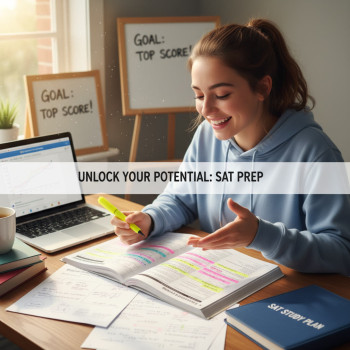Why a Gap Year Can Be the Best Time to Crush the SAT
Taking a gap year doesn’t mean pausing your college goals; for many students it’s a chance to sharpen them. If you’re planning to take the Digital SAT during your gap year, you’re in an excellent position: you have flexible time, fewer school distractions, and room to build a study plan that fits the life you want to live. This guide is for students who want clarity, steady progress, and a plan that respects both learning and living.
Think of the Gap Year as ‘A Year On,’ Not ‘A Year Off’
Gap years are often described as opportunities to explore, work, travel, volunteer, or gain life experience. They’re also a golden chance to prepare for standardized tests in a way that actually complements your broader goals. With the right structure, you can make measurable score gains while growing in confidence, independence, and perspective—qualities colleges notice.
Set a Clear, Realistic Target
Before textbook sprints and practice tests, pick a target score. This gives focus to every hour you spend studying. Your target should be based on the range of admitted students at the colleges you plan to apply to, but make it personal: choose a number that’s challenging yet reachable.
How to Pick a Target
- List 3–5 colleges you’re interested in and note their middle 50% SAT range.
- Pick a target near the upper-middle of that range—this gives you a competitive edge without unrealistic pressure.
- If your gap year plans include applying early in the cycle, set the test date first and work backward from there.
Make a Semester-Style Study Plan
Structure matters. Treat your gap year like a semester: set milestones, vary your focus, and build in rest. Below is a sample 12-week plan tailored for a gap year student who has the flexibility to study 10–15 hours a week. Adjust the weeks and hours depending on your schedule.
| Weeks | Primary Focus | Weekly Routine | Goal |
|---|---|---|---|
| 1–2 | Baseline & Diagnostic | 1 full official practice test; review weaknesses; 4 practice sessions | Understand where you stand; set score target |
| 3–6 | Content & Strategy (Math & Reading) | 6–8 focused lessons; 2 timed sections; daily 30–60 min skill work | Solidify fundamentals; learn Digital SAT question types |
| 7–9 | Practice Tests & Error Analysis | 1 full test every 7–10 days; deep review sessions; targeted drills | Improve timing and accuracy; reduce careless errors |
| 10–11 | Polish & Test Readiness | Light content review; test-day routines; device and Bluebook practice | Simulate test-day conditions; build confidence |
| 12 | Restorative Week & Final Test | Light review, rest, one final practice test mid-week | Arrive at test day fresh and focused |
Why a Semester Model Works
It balances intense learning blocks with consolidation. Practicing in cycles—learn, apply, review—helps knowledge stick, especially when life during a gap year includes new experiences that could otherwise pull attention away from study.
Work with Official Practice and Realistic Tools
The Digital SAT is different from the old paper-and-pencil format. Make sure you practice with official digital tools and familiarity with the testing platform. Spend time in the same environment you’ll use on test day: practice on a laptop or device that mirrors the testing app’s layout, timing, and navigation.
- Use official full-length practice tests to measure progress.
- Simulate test-day conditions (timed sections, minimal breaks, and device readiness).
- Learn the digital platform’s navigation—how to flag questions, how to mark passages, and how the adaptive format affects strategy.
Daily Habits That Add Up
Small, consistent actions beat sporadic all-nighters. During a gap year you have room to build habits that last—here are a few that make a difference:
- Micro practice: 20–40 minutes of focused study most days rather than 5-hour marathons once a week.
- Error logs: Record every mistake and why it happened—concept gap, misread, timing, or silly error.
- Reading routine: 30 minutes of high-quality reading daily—op-eds, science features, or literary essays—to build comprehension speed and vocabulary context.
- Math warm-ups: Short daily problem sets for fluency in algebra, functions, and problem solving.
Sample Weekly Block
- Monday: Focused math practice + error log review (60–90 minutes)
- Tuesday: Reading practice (timed passages) + vocabulary in context (45–60 minutes)
- Wednesday: Writing & language strategies + practice passages (45 minutes)
- Thursday: Mixed practice set (timed; 1–2 sections) + review
- Friday: Concept study (videos or lessons) using official resources (60 minutes)
- Saturday: Longer practice block or full section test (2–3 hours)
- Sunday: Rest, light review, or a reflection journal to track progress and mood
Use Your Gap Year Activities as Study Fuel
One of the joys of preparing during a gap year is that real-world activities can reinforce SAT skills. Whether you’re volunteering, interning, or traveling, there are ways these experiences make your studying richer and less isolating.
- If you’re reading about local issues while volunteering, treat one article a day like a reading passage—summarize main ideas and identify supporting evidence.
- If you’re working, practice time management by timing study sprints around shifts—this builds stamina for test-day focus.
- Write short reflections on projects to sharpen concision and organization—skills that translate to the Writing & Language section.
Practice Tests: When and How Often
Practice tests should be checkpoints, not punishment. Early on, take a diagnostic test to determine weak spots. As you progress, schedule full-length digital practice tests every 7–14 days. Use them to train pacing, identify recurring errors, and test strategies under realistic conditions.
How to Review a Practice Test
- First pass: Score it and note timing problems.
- Second pass: For every missed question, write why you missed it in your error log (concept, careless, misread, time pressure).
- Third pass: Create a mini-study plan to target those error types for the next two weeks.
Personalized Support: When and How to Bring in a Tutor
Many gap year students find targeted tutoring accelerates progress. If you’ve plateaued or need help turning weaknesses into strengths, 1-on-1 tutoring can be the catalyst. Work with a tutor who understands the Digital SAT’s format, can build a tailored plan, and offers accountability without micromanaging your life.
For example, Sparkl’s personalized tutoring blends expert tutors with tailored study plans and AI-driven insights to identify and attack specific weaknesses—perfect for a gap year where efficient progress matters. Sparkl can help with focused one-on-one guidance, creating a study schedule that fits gap-year activities, and providing data-driven feedback to optimize practice.
How to Choose a Tutor or Program
- Look for someone who uses official digital practice materials and understands the Bluebook testing environment.
- Choose tutors who give measurable homework and track progress with practice-test data.
- Prioritize a collaborative teacher-student relationship—your tutor should help you build independence, not dependency.
Time Management for a Gap Year: Balance Study with Life
The flexibility of a gap year is both a blessing and a risk: without structure, momentum fades. Build gentle accountability into your plan so studying fits into your life without taking it over.
- Block schedule: Create weekly blocks for study, work, travel, and rest.
- Habit anchors: Attach study sessions to daily anchors (coffee, morning walk) to make them non-negotiable.
- Weekly check-ins: Review progress every Sunday and adjust the coming week.
- Accountability buddy: Pair with a friend or a tutor for weekly mini-goals.
Test-Day Readiness: Device, Logistics, and Mindset
The Digital SAT has practical details that matter on test day—device readiness, the testing app, and small logistics. Don’t leave these to chance.
- Bluebook practice: Install and practice in the app you’ll use on test day well before the exam.
- Device check: Make sure your device meets requirements and that you know how to borrow one if needed.
- Test center logistics: Know your test center location, commute time, and what you can and can’t bring.
- Pack the night before: snacks (if allowed between sections), water, ID, fully charged device (if applicable), and a paper copy of your plan.
Calming the Test-Day Mindset
Test anxiety is real, but manageable. The gap year gives you time to practice mindfulness and build routines that reduce stress. Try breathing exercises, a 10-minute pre-test ritual, or a confidence playlist to get into the right headspace.
How to Use Score Reports and Re-Test Strategically
If your first score isn’t where you want it, don’t panic: many students improve with targeted follow-up work. Use your score report to isolate patterns—are errors clustered by content area, question type, or timing? Build a short re-test plan based on that analysis.
- Wait a week after receiving scores to plan next steps—this gives you perspective.
- If you decide to re-test, pick a date that leaves you 6–10 weeks to work on targeted weaknesses.
- Keep the long view: one test is data; your consistent improvement is the story.
Examples & Mini Case Studies
Seeing how others have structured gap-year study can spark ideas. Here are two short, typical profiles:
Case 1: Maya — Intern, Part-Time Student, Focused Gains
Maya spent her gap year interning at a local design studio and had 8–12 hours a week free. She did a diagnostic, targeted algebra and reading weaknesses, and took a full-length practice test every 10 days. After 3 months of consistent micro-sessions and two months of intense review with a tutor for targeted weak spots, she improved by 90 points and felt confident applying the next cycle.
Case 2: Jordan — Traveler and Volunteer
Jordan combined travel with study—reading local news for comprehension practice and scheduling morning study sprints. He used a tutor intermittently for 1-on-1 sessions to analyze practice-test mistakes and calibrate timing. Jordan found that embedding quick habits into travel days (20–30 minutes of focused practice) kept momentum without compromising the experience.
Checklist for the Last 30 Days Before Your Test
- Take 1–2 full digital practice tests under timed, realistic conditions.
- Finalize test day logistics (location, transport, ID, device prep).
- Taper study intensity in the last 3–5 days—prioritize light review and sleep.
- Practice your pre-test ritual and breathing exercises.
- Confirm accommodations or device lending if you need them.
Final Thoughts: Make the Gap Year Yours
Preparing for the SAT during a gap year should enhance your growth, not constrict it. Build a plan that fits the life you want to lead during that year: carve out steady study time, use official digital practice, bring in personalized help when needed, and let your real-world experiences deepen your reading, reasoning, and resilience.
If you want structure without losing flexibility, consider combining official practice with occasional targeted tutoring. Services like Sparkl (with 1-on-1 guidance, tailored study plans, expert tutors, and AI-driven insights) can help optimize your time and keep your progress focused. When used thoughtfully, tutoring becomes a lens that sharpens self-study, not a crutch.
Above all, keep perspective. The SAT is an important piece of your application, but it’s only one of many ways you’ll show who you are. Use your gap year to grow as a learner and as a person—your scores will follow. Good luck; you’ve got this.












No Comments
Leave a comment Cancel